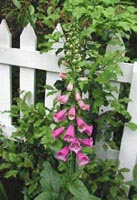Resource Library
Plant of the Week: Foxglove
The University of Arkansas System Division of Agriculture does not promote, support or recommend plants featured in "Plant of the Week." Please consult your local Extension office for plants suitable for your region.
Plant of the Week
Foxglove
Latin: Digitalis purpurea

The line between myth and reality is often unmarked, especially as we look backwards through the mist of time. Foxglove, that rocket of a flower that launches itself from a pad of large basal leaves in April and May, illustrates how we still carry with us vestiges of this fuzzy borderland into our modern age.
Foxglove (Digitalis purpurea) is a biennial or short-lived perennial belonging to the snapdragon family, a native of western Europe. In its first year of life, foxglove seedlings produce a rosette of green, fleshy, simple leaves, which are unremarkable in appearance.
But, in the spring, this rosette begins to shoot skyward with leaves shrinking in size as they near the flowering scape. Older plants may produce several blooming scapes, but young plants are usually unbranched.
The 3-inch long, tubular purple flowers begin opening at the base of the scape, while the blooms above it are progressively smaller as they await their day of opening. The inside of the tubular flower is lighter colored and marked with irregular batches of dark brown. Hybridizers have given us an array of flower colors in this increasingly popular plant with white, pink, apricot and bicolor selections now available.
The name foxglove is from the old English name "foxes glofa." It comes from an old myth that foxes must have used the flowers to magically sheath their paws as they stealthily made their nocturnal raids into the poultry yards of rural folk. The association is natural for the foxgloves grew on the wooded hillside slopes that foxes chose for their dens.
In 1542, Leonhard Fuchs, after whom fuchsia is named, gave the plant it's current Latin moniker - Digitalis - for the finger (ie. digit) shaped flowers. The species epitaph purpurea was adapted by Linnaeus two centuries later.
Like most plants in the European flora, foxglove was used as part of the herbal medicine chest before the development of the modern pharmacopeia. But its use was relegated to that of a general cleaning agent, to purge the body of whatever ailed it.
It was not until 1775 that an English physician named William Withering, acting on a account supplied by an herbal healer, reported that a tea made from it was useful in curing dropsy, the fluid accumulation often associated with heart-related problems. Since that time, the drug digitalin has become one of the old, generic drugs doctors and HMO's consider the first line of defense against heart-related ailments.
Foxglove is a mainstay of the spring garden where it can reseed freely if it finds the site to its liking. It has naturalized in the wild in Pacific Northwest and in a few areas of New England, but in the South it's propensity to procreate is much reduced. It grows in full sun or medium shade and usually persists for three or four years if it finds the site to its liking. It does best in a moderately fertile, well-drained soil that receives some water during the summer.
Foxgloves are easy to grow from seed, and gardeners wanting to add them to their garden for next spring will find this easy and rewarding. Seeds can be planted outside in containers in May or June. Seed germination is easy and seedlings can usually be transplanted to a growing on container after three or four weeks.
The first-year plants should be planted in their final location in the garden during September so that they can establish themselves before cold weather arrives.
By: Gerald Klingaman, retired
Extension Horticulturist - Ornamentals
Extension News - May 17, 2002
The University of Arkansas System Division of Agriculture does not maintain lists of retail outlets where these plants can be purchased. Please check your local nursery or other retail outlets to ask about the availability of these plants for your growing area.